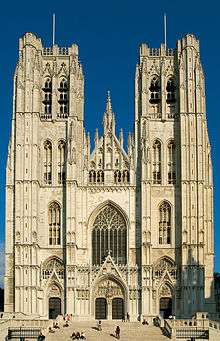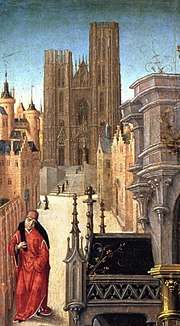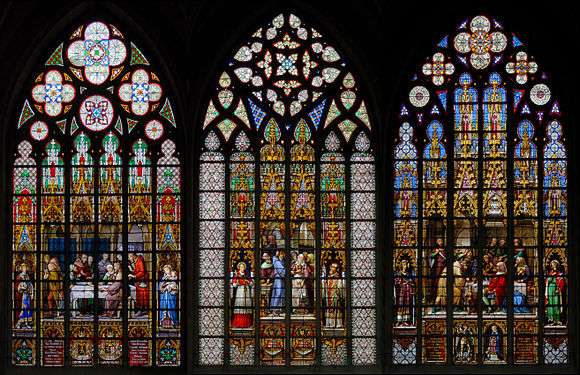Cathedral of St. Michael and St. Gudula
The Cathedral of St. Michael and St. Gudula (French: Cathédrale des Saints Michel et Gudule, Dutch: Kathedraal van Sint-Michiel en Sint-Goedele[2]) is a medieval Roman Catholic church in central Brussels, Belgium. It is consecrated to St. Michael and St. Gudula, the patron saints of the City of Brussels, and is considered to be one of the finest examples of Brabantine Gothic architecture.
| Cathedral of St. Michael and St. Gudula | |
|---|---|
 | |
| 50°50′52″N 4°21′37″E | |
| Location | Parvis Sainte-Gudule / Sinter-Goedelevoorplein B-1000 City of Brussels, Brussels-Capital Region |
| Country | Belgium |
| Denomination | Roman Catholic |
| History | |
| Status | Co-cathedral (Cathedral status from 1962) |
| Dedication | Saint Gudula and Saint Michael (patron saints of Brussels) |
| Architecture | |
| Functional status | Active |
| Heritage designation | Protected[1] |
| Designated | 05/03/1936 |
| Architectural type | Church |
| Style | Gothic, Brabantine Gothic |
| Years built | 11th–15th centuries (church) 1485 (facade and towers) |
| Groundbreaking | c. 9th century (chapel) |
| Completed | 1519 |
| Specifications | |
| Number of towers | 2 |
| Number of spires | 2 |
| Spire height | 64 metres (210 ft) |
| Administration | |
| Archdiocese | |
| Clergy | |
| Archbishop | Jozef De Kesel (Primate of Belgium) |
| Dean | Claude Castiau |
| Laity | |
| Organist(s) | Xavier Deprez |
The church's construction began in the 11th century and was largely complete by the 16th, though its interior was frequently modified in the following centuries. The church was given cathedral status in 1962 and has since been the co-cathedral of the Archdiocese of Mechelen-Brussels, together with St. Rumbold's Cathedral in Mechelen.[2] Since the mid-20th century, following the construction of the North–South connection, it has been located on the Parvis Sainte-Gudule/Sinter-Goedelevoorplein, east of Boulevard de l'Impératrice/Keizerinlaan. This site is served by Brussels Central Station.
History

A chapel dedicated to St. Michael was probably built on the Treurenberg hill as early as the 9th century. In the 11th century, it was replaced by a Romanesque church. In 1047, Lambert II, Count of Leuven founded a chapter in this church and organised the transportation of the relics of the martyr St. Gudula, housed before then in Saint Gaugericus Church on Saint-Géry Island. The patron saints of the church, St. Michael and St. Gudula, are also the patron saints of the City of Brussels.
In the 13th century, Henry I, Duke of Brabant ordered two round towers to be added to the church. Henry II, Duke of Brabant instructed the building of a Brabantine Gothic collegiate church in 1226. The choir was constructed between 1226 and 1276. It took about 300 years to complete the entire church. It was completed just before the reign of the Emperor Charles V began in 1519.[3] Some chapels were added in the 16th and 17th centuries.
The church was designated a historic monument on 5 March 1936.[4] It was not until 1962, with the creation of the Archdiocese of Mechelen-Brussels, that the collegiate church was promoted to the rank of co-cathedral, when it became the seat of the Archbishop, together with St. Rumbold's Cathedral in Mechelen.[5]
Restoration work was carried out in the 19th century under the direction of the architect Tilman-François Suys who restored the towers and portals from 1839 to 1845, and again in the 20th century under the direction of Jean Rombaux then Victor Gaston Martiny, chief architect-town planner of the Province of Brabant and member of the Royal Committee for Monuments and Sites. The cathedral was once again thoroughly restored between 1983 and 1999. On that occasion, remains of the Romanesque church as well as the Romanesque crypt were discovered under the current choir.[5]
Features
Exterior

The cathedral is built of stone from the Gobertange quarry, which is located approximately 45 km (28 mi) south-east of the site of the cathedral. The building's external length is 114 m (374 ft) and its internal length is 109 m (358 ft), and the choir's exterior is 57 m (187 ft) wide and its interior 54 m (177 ft) wide. The western facade with its three portals surmounted by gables and two 64 m (210 ft) high towers are typical of the French Gothic style, but without a rose window, as it features instead a large window in the Brabantian Gothic style.
The two towers, the upper parts of which are arranged in terraces, are attributed to the Flemish architect Jan Van Ruysbroeck (1470–1485), who also designed the tower of Brussels' Town Hall. They are unfinished and were meant to be much higher, in a style close to the Town Hall's tower or the north tower of the Cathedral of Our Lady in Antwerp.
The monumental staircase for the cathedral, designed by Pieter Paul Merckx, was placed in the period 1702–1707. This staircase, a gift from the city of Brussels, was originally built against the city walls to provide access to the promenade on the stretch between the Laeken Gate and the Schaerbeek Gate.
Interior

The choir is Gothic and contains the mausoleums of the Dukes of Brabant and Archduke Ernest of Austria made by Robert Colyn de Nole in the 17th century. Left of the choir is the Chapel of the Flamboyant Gothic Blessed Sacrament of the Miracle (1534–1539). It now houses the Treasure of the Cathedral, where the famous Drahmal Cross (also known as the Brussels Cross), an Anglo-Saxon inscribed cross-reliquary of the early 11th century, is stored. Right of the choir is the Chapel of Our Lady of Deliverance (1649–1655) which is built in a late Gothic style and has a Baroque altar by Jan Voorspoel (1666).[3] Behind the choir is a Baroque chapel dedicated to St. Mary Magdalen (also called the Maes Chapel) dated 1675 and a marble and alabaster altarpiece depicting the Passion of Christ by Jean Mone dated 1538.[3]
The nave has all the characteristics of Brabantine Gothic: the four-part vaults are moderately high and the robust cylindrical columns that line the central aisle of the nave are topped with capitals in the form of cabbage leaves. Statues of the 12 apostles are attached to the columns. These statues date from the 17th century and were created by sculptors Lucas Faydherbe, Jerôme Duquesnoy the Younger, Johannes van Mildert and Tobias de Lelis, all renowned sculptors of their time. The statues replaced those destroyed by iconoclasts in 1566.
The nave has a Baroque pulpit from the 17th century, made by Antwerp sculptor Hendrik Frans Verbruggen in 1699. The base represents Adam and Eve expelled from the Garden of Eden after plucking the forbidden fruit. At the top, the Virgin and Child piercing the serpent symbolise redemption.[3]
To the right of the portal of the northern transept is an elegant 17th-century sculpture depicting The education of the Holy Virgin by Saint Anna by Jerôme Duquesnoy the Younger after a painting by Rubens.[3] The side aisles contain 17th-century confessional-boxes in oak by Jan van Delen.
The cathedral contains the unmarked burial place of Dermot O'Mallun, the last Irish-born chief of the name of the O'Moloney sept of Thomond. [6]
Stained glass
The cathedral has stained glass windows from the 16th, 17th and 19th centuries. Particularly noteworthy are the two made in 1537 and 1538 by the Antwerp glassmaker Jean Haeck based on drawings by Bernard van Orley. They adorn the northern and southern transepts, and bear the image of Charles V. Also worth mentioning are the impressive series of fifteen stained glass windows from the 19th century in the aisles, produced by Jean-Baptiste Capronnier. They were created in 1870, for the celebration of the fifth centenary of the Legend of the Miraculous Sacrament.[5]
_(5).jpg) Southern transept: detail of a stained glass window by Jean Haeck depicting Charles V (1538)
Southern transept: detail of a stained glass window by Jean Haeck depicting Charles V (1538)- Nave of the cathedral: stained glass window by Jean-Baptiste Capronnier (c. 1870)
 Three scenes of the Legend of the Miraculous Sacrament. Stained glass windows by Capronnier (c. 1870)
Three scenes of the Legend of the Miraculous Sacrament. Stained glass windows by Capronnier (c. 1870)
Organ
The big organ in the nave was inaugurated in October 2000. The organ has 4300 pipes, 63 stops, four manuals and one pedal. This instrument is the work of the German organ builder Gerhard Grenzing and his Spanish assistants from Barcelona.
Bells
Both towers contain bells. The south tower contains a 49-bell carillon by the Royal Eijsbouts bell foundry from 1966, on which Sunday concerts are often given. Out of all the bells in the carillon, only 7 of them can ring. They are, from heaviest to lightest: Fabiola, Maria, Michael, Gudula, Philippe, Astrid, and Laurent. Fabiola, Philippe, Astrid and Laurent are named after members of the Belgian royal family.
The north tower contains a single bourdon called Salvator, it was cast by Peter van den Gheyn in 1638. There is also another empty space where a second bourdon used to be. The bourdon has a deep crankshaft, but counterweights have already been removed. There are plans to hang it again on a straight axis with a flying clapper.
| Nr. | Name | Mass (kg) | Note | Tower |
|---|---|---|---|---|
| 1 | Salvator | 6645 | G0 | North |
| 2 | Fabiola | 3164 | B♯0 | South |
| 3 | Maria | 2298 | C1 | South |
| 4 | Michael | 1628 | D1 | South |
| 5 | Gudula | 1332 | E1 | South |
| 6 | Philippe | 975 | F1 | South |
| 7 | Astrid | 690 | G1 | South |
| 8 | Laurent | 485 | A1 | South |
Trivia
Falcons in the cathedral
At the end of the 1990s, Brussels ornithologists discovered a couple of peregrine falcons hibernating on top of the towers of the cathedral. In 2001, ornithologists of the Royal Belgian Institute of Natural Sciences (RBINS) in association with the Fonds d’Intervention pour les Rapaces installed a laying-nest on the edifice in an attempt to encourage nest-building. This laying-nest was never used, but in the spring of 2004, a pair of falcons nested on a balcony on top of the cathedral’s northern tower. At the beginning of March, the female laid three eggs.
As a result of watching the three chicks perform acrobatic feats on the cathedral’s gargoyles, at the end of May 2004, the project "Falcons for everyone" was developed by the RBINS in association with the Commission Ornithologique de Watermael-Boitsfort. The project installed cameras with a live video stream on their website.[7]
Administration
The Cathedral of St. Michael and St. Gudula serves as the co-cathedral of the Archbishop of Mechelen-Brussels, the Primate of Belgium, who is currently Archbishop Jozef De Kesel. Due to its importance and its location in the national capital, it is often used for Catholic ceremonies of national interest, such as royal marriages and state funerals.[8] For example, in 1999, it was the setting for the wedding of Prince Philippe and Mathilde d'Udekem d'Acoz.
See also
- List of cathedrals in Belgium
- List of churches in Brussels
- Roman Catholicism in Belgium
References
- "Bruxelles Pentagone - Cathédrale des Sts Michel et Gudule - Parvis Sainte-Gudule". www.irismonument.be. Retrieved 2019-05-12.
- Cathedral of St. Michael and St. Gudula on GCatholic.org
- History and architecture overview Archived 2012-07-21 at Archive.today on the official site of the Cathedral
- "Bruxelles Pentagone - Cathédrale des Sts Michel et Gudule - Parvis Sainte-Gudule". www.irismonument.be. Retrieved 2019-05-12.
- "History | Brussels Cathedral". Retrieved 2020-01-25.
- Moloney, Gerry. "Resurrecting an ancient chief". History Ireland. History Publications Ltd. Retrieved 13 November 2019.
- "Falcons for everyone - Peregrine falcons on the cathedral". www.falconsforeveryone.be. Retrieved 2016-08-15.
- National events in the Cathedral Archived 2012-07-24 at Archive.today on the official site of the Cathedral
External links
| Wikimedia Commons has media related to Cathedral of St. Michael and St. Gudula (Brussels). |